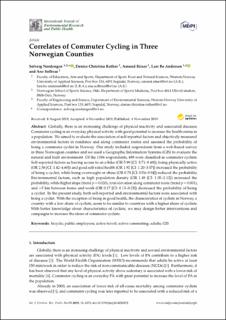| dc.contributor.author | Nordengen, Solveig | |
| dc.contributor.author | Ruther, Denise Christina | |
| dc.contributor.author | Riiser, Amund | |
| dc.contributor.author | Andersen, Lars Bo | |
| dc.contributor.author | Solbraa, Ane Kristiansen | |
| dc.date.accessioned | 2020-05-12T13:22:19Z | |
| dc.date.available | 2020-05-12T13:22:19Z | |
| dc.date.created | 2019-11-26T09:03:40Z | |
| dc.date.issued | 2019 | |
| dc.identifier.citation | International Journal of Environmental Research and Public Health. 2019, 16(22), 4372. | en_US |
| dc.identifier.issn | 1660-4601 | |
| dc.identifier.uri | https://hdl.handle.net/11250/2654118 | |
| dc.description | This is an open access article distributed under the Creative Commons Attribution License (https://creativecommons.org/licenses/by/4.0/) which permits unrestricted use, distribution, and reproduction in any medium, provided the original work is properly cited. | en_US |
| dc.description.abstract | Globally, there is an increasing challenge of physical inactivity and associated diseases. Commuter cycling is an everyday physical activity with great potential to increase the health status in a population. We aimed to evaluate the association of self-reported factors and objectively measured environmental factors in residence and along commuter routes and assessed the probability of being a commuter cyclist in Norway. Our study included respondents from a web-based survey in three Norwegian counties and we used a Geographic Information Systems (GIS) to evaluate the natural and built environment. Of the 1196 respondents, 488 were classified as commuter cyclists. Self-reported factors as having access to an e-bike (OR 5.99 [CI: 3.71–9.69]), being physically active (OR 2.56 [CI: 1.42–4.60]) and good self-rated health (OR 1.92 [CI: 1.20–3.07]) increased the probability of being a cyclist, while being overweight or obese (OR 0.71 [CI: 0.54–0.94]) reduced the probability. Environmental factors, such as high population density (OR 1.49 [CI: 1.05–2.12]) increased the probability, while higher slope (trend p = 0.020), total elevation along commuter route (trend p = 0.001), and >5 km between home and work (OR 0.17 [CI: 0.13–0.23]) decreased the probability of being a cyclist. In the present study, both self-reported and environmental factors were associated with being a cyclist. With the exception of being in good health, the characteristics of cyclists in Norway, a country with a low share of cyclists, seem to be similar to countries with a higher share of cyclists. With better knowledge about characteristics of cyclists, we may design better interventions and campaigns to increase the share of commuter cyclists. | en_US |
| dc.language.iso | eng | en_US |
| dc.subject | bicycle | en_US |
| dc.subject | public employees | en_US |
| dc.subject | active travel | en_US |
| dc.subject | active commuting | en_US |
| dc.subject | adults | en_US |
| dc.subject | GIS | en_US |
| dc.title | Correlates of Commuter Cycling in Three Norwegian Counties | en_US |
| dc.type | Peer reviewed | en_US |
| dc.type | Journal article | en_US |
| dc.description.version | publishedVersion | en_US |
| dc.rights.holder | © 2019 by the authors. | en_US |
| dc.source.pagenumber | 18 | en_US |
| dc.source.volume | 16 | en_US |
| dc.source.journal | International Journal of Environmental Research and Public Health | en_US |
| dc.source.issue | 22 | en_US |
| dc.identifier.doi | 10.3390/ijerph16224372 | |
| dc.identifier.cristin | 1752184 | |
| dc.description.localcode | Seksjon for idrettsmedisinske fag / Department of Sports Medicine | en_US |
| cristin.unitcode | 150,34,0,0 | |
| cristin.unitname | Seksjon for idrettsmedisinske fag | |
| cristin.ispublished | true | |
| cristin.fulltext | original | |
| cristin.qualitycode | 1 | |
